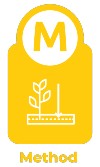Nutrient Management
Crops need nutrients to grow and thrive, but effective nutrient management is not one-size-fits-all. A nutrient management plan is specific to your land, the crops you grow, and many other factors that change over time. No matter the crops you produce or size of your operation, USDA can help you reduce input costs, maximize yields, and efficiently manage nutrients to support your bottom line and protect the environment.
On average, farmers can save nearly $30 per acre on land currently receiving excess nutrients by implementing a nutrient management plan. Watch USDA’s Under Secretary for Farm Production and Conservation Robert Bonnie discuss the importance of nutrient management.
On This Page
SMART Nutrient Management
USDA’s Natural Resources Conservation Service (NRCS) works with farmers to develop nutrient management plans that optimize plant yields while reducing the amount of nutrients lost to the environment, where they can impact greenhouse gas emissions and air and water quality.
SMART Nutrient Management includes the 4Rs of nutrient stewardship – the right Source, right Method, right Rate, and right Timing – and emphasizes smart activities to reduce nutrient loss by Assessment of comprehensive, site-specific conditions.
A SMART Nutrient Management Plan considers all conditions on the farm and how they influence one another. It is tailored to the unique farm location, soil, climate, crops grown, management conditions, and other site-specific factors.
Below are the factors to consider when developing a SMART Nutrient Management Plan.
Source

Farmers may apply commercial fertilizers, manure, soil amendments, or organic-by-products to provide the nutrients plants need. When determining the nutrient source that’s best for your operation, here are some things to consider:
- Best match. Choose the right nutrient sources to best match the needs of your crop and soil while minimizing the site-specific risk of nutrient loss. Needs vary depending on your local soil and climate conditions, specific crop, and conservation practices you implement such as reduced tillage, no-till, or cover crops.
- Utilization needs. Select nutrients based on your utilization needs. If you have a new planting, you may need a delayed uptake just after seed germination. Or, you may have an established crop that’s ready to take up nutrients immediately.
- Testing. Test to confirm key nutrient needs for your soil and plants. Soil tests can help you to identify the key nutrients your soil needs so you can make an informed decision on the correct fertilizer and the right quantity for your crops. Plant tissue tests can also add valuable insights. Similarly, test manure, soil amendments, or organic by-products. If you use manure or organic by-products, testing the manure for nutrient content can help meet crop nutrient needs more efficiently. This leads to increased profit and decreased risk of pollution.
SMART Tip: Testing is the most reliable way to determine what your soil and crop needs to select the best nutrient source. Testing is a key component in nutrient management planning. Contact your local extension service for more information on testing.
Method

For effective nutrient management, method of application can make all the difference. When determining how and where you apply nutrients, here are some things to consider:
- Injection. Getting nutrients down below the surface of the soil and into the root zone of your crop increases the plant’s ability to access them. Injecting nutrients is one way to deliver them exactly where they’re needed.
- Incorporation. Specific sites may require nutrients to be incorporated into the soil, not just broadcast on the surface, for plants to adequately access them and to reduce the risk of nutrient loss in runoff events. This can be true even if you practice reduced tillage or no-till. In these systems, nutrient placement with the planter or injection via a no-till, low disturbance application tool are effective methods for nutrient incorporation. If a broadcast method is utilized, some sites may benefit from a low intensity incorporation of manure or fertilizer following the application.
- Other practices combined. If incorporation or injection are not practical, combine in-field conservation practices with edge-of-field practices to reduce nutrient losses.
- GPS and other technologies. Different parts of your land may have different nutrient requirements. Global Positioning Systems (GPS) and variable rate application are some of the technologies that can help make sure your applying nutrients in the right amounts in the right places.
Assessment

Each plot of land is different. A key part of nutrient management planning is assessing the site-specific conditions of your land and operation to determine what is needed. All conditions on your farm must be considered because each affects the others. In addition, as changes are made to your operation, the on-site conditions should be re-assessed, and the plan should be adjusted accordingly.
Here are some things to consider:
- Certified nutrient management planning. A certified nutrient management planner can analyze your specific land conditions, perform a risk assessment and draft a nutrient management plan that is tailored to your land.
- Current or planned practices. Current or planned practices – such as cover crops, no-till, or conservation tillage – should be assessed to determine how they might affect nutrient requirements and reduce nutrient losses.
- Testing. Testing and analysis can tell you what nutrients are already present in the soil, soil amendment, or plant, to determine what nutrients are needed.
Rate

Many factors affect the amount of nutrients your crop needs. When determining the amount or rate for your application, here are some things to consider:
- Testing. Having your soil, plants, and – if necessary – nutrient source tested will let you know what nutrients are needed, and how much you should apply given your specific source.
- Soil health practices. These conservation practices, such as no-till or cover crops, naturally increase soil organic matter and biological processes, and thereby may reduce your fertilizer needs.
- Technology. Variable rate application technology, for example, can improve nutrient efficiency by delivering specific amounts according to historic yields and soil-test nutrient levels.
Timing

Appropriately timing the application of nutrients is critical. When determining when to apply nutrients, here are some things to consider:
- Crop demand. Nutrients should be applied when crops need them most to maximize uptake and effectiveness. You may split-apply nitrogen, for instance, to deliver nutrients at targeted times during the growing season.
- Weather and seasonal conditions. Application of fertilizer immediately before a large rainfall could contribute to nutrient runoff.
- The technology you have available. Technologies such as precision guidance systems allow producers to apply fertilizer to actively growing crops.
Get Help with a SMART Nutrient Management Plan for Your Land
NRCS offers voluntary programs and free one-on-one technical assistance to support a range of conservation goals, including nutrient management. Contact the NRCS office at your local USDA Service Center to get started with a nutrient management plan for utilizing and applying nutrients such as nitrogen (N), phosphorus (P), and potassium (K) on your cropland operation.
A local NRCS conservationist can help you evaluate your specific nutrient needs, assess your site-specific risks for nutrient and soil loss, and discuss opportunities to address those risks. This will result in a plan that includes details such as:
- Soil information – soil type, surface texture, drainage class, permeability, available water capacity, depth to water table, restrictive features, and flooding and ponding frequency.
- Available test results – for soil, water, compost, manure, organic by-product, and/or plant tissue sample analyses – to be leveraged in planning.
- Results of appropriate risk assessments for potential N, P, and erosion losses specific to your operation.
- Crop nutrient budget for the crop rotation, using your recent crop average yields.
- Science-based recommendations for the right source, application method, rate, and timing for all nutrient sources that are planned for use.
- Tips to support implementation and maintenance of your individual nutrient management plan.
Many of the tools for nutrient management planning don’t require a big investment. Using methods like soil and manure testing, in-season plant tissue testing, enhanced efficiency fertilizer products, and split application are examples of low-cost ways for managing nutrients more efficiently.
Climate-Smart Agriculture and Nutrient Management
Nutrient management is an important part of climate-smart agriculture. Excess nutrients on the land can lead to nitrogen losses to the atmosphere. Nutrient management maximizes crop-nitrogen uptake and has a compelling and cost-effective role to play in mitigating greenhouse gas emissions from agriculture.
The Inflation Reduction Act will deliver $19.5 billion in new conservation funding to support climate-smart agriculture, including for NRCS to improve opportunities for nutrient management. NRCS will target funding, increasing program flexibilities, launch a new outreach campaign to promote nutrient management’s economic benefits, and expand partnerships to develop nutrient management plans. This is part of USDA’s broader effort to address future fertilizer availability and cost challenges for U.S. producers.

![]()
![]()
![]()
![]()
![]()